In the competitive landscape of online retail, simply driving traffic to your website isn’t enough. The real measure of success lies in your ability to turn those visitors into paying customers. That’s why a focus on increasing conversion rates is so critical to eCommerce success. For your eCommerce business, a higher conversion rate means more sales from the same amount of traffic, directly boosting your revenue and profitability. Understanding how to increase conversion rates online isn’t just a metric to track, it’s a critical lever for growth. This guide will provide actionable conversion rate optimization best practices and dive into how to increase eCommerce conversion rates effectively.
Knowing When to Improve Your eCommerce Conversion Rate
If your traffic is growing but sales aren’t keeping up, it’s a clear sign your site may not be converting visitors effectively. Here are key indicators that you need to invest in conversion rate optimization:
- High traffic, low sales – If you’re getting strong sessions but a low purchase rate, there’s friction in your funnel.
- Cart abandonment – Are users adding products to cart but not completing checkout?
- Low mobile conversion rate – Over 50% of traffic is mobile, but mobile CRO is often neglected.
- High bounce rate on product pages – Shoppers may not be finding what they need quickly.
- Poor performance from key landing pages – Especially if they’re tied to paid traffic or campaigns.
Understanding where and why visitors drop off is the first step to increasing your conversion rate. Not sure where you stand? As a benchmark, US eCommerce stores see average conversion rates as 3.35%, but this varies widely by sector and audience.
Why eCommerce shoppers don’t convert
The reasons shoppers don’t convert are extremely varied. Some are easily quantifiable whilst others are harder to predict. Of the more quantifiable examples, these can include:
- Not enough product information
- Poor navigation / hard to use
- Unclear or conflicting ‘call to actions’
- Low quality imagery
- Lack of shopper trust
- Minimal social proof
- Long and complex checkout
- Slow website
- Price too high
- Product not available
Reasons that are harder to measure could include:
- The online equivalent of ‘window shopping’: This passive browsing state may be an individual who has no intention of buying but simply enjoys seeing the latest a brand has to offer
- Pre pay-day browsing: At this point, a shopper may be adding items to their wishlist but will be returning following payday. It is quite common for retailers to see a spike at the beginning of the month for this reason
- Waiting for sales: Shoppers become accustomed to sales periods whether this be mid-season sales or the more common end of season or holiday sales
Best practices to increase your eCommerce conversion rate
1. Enhance User Experience (UX) with persuasive design and clear copy:
The first strategy to increase conversions across your eCommerce site is persuasive design, there are 5 key elements to persuasive design:
1 – Clear Information: Shoppers should immediately know who you are, what value you provide and why they should care
2 – Visual Appeal: As with the copy, this should be simple and easily direct shoppers to where you want them to go
3 – Visual Hierarchy: What do you want shoppers to engage with first? This should be at the top of your visual hierarchy
4 – Grab and retain attention: The focus here is on engaging with your shoppers. What encourages shoppers to go deeper into your site than simply visiting the homepage?
5 – Match user intent: Be clear on what the intention of each page is and make all elements on the page focus towards that purpose. This doesn’t necessarily mean limiting yourself to one CTA but if the purpose is to get people to buy, then how do you make this easy for them? i.e. one CTA may be ‘buy now’ whilst another is ‘add to wishlist’ to help make it easier for them to buy in the future.
Visitors to www.marksandspencer.com are welcomed with a large header that immediately captures their attention featuring bold heading and visuals and relevant content such as sales, new items and other promos.
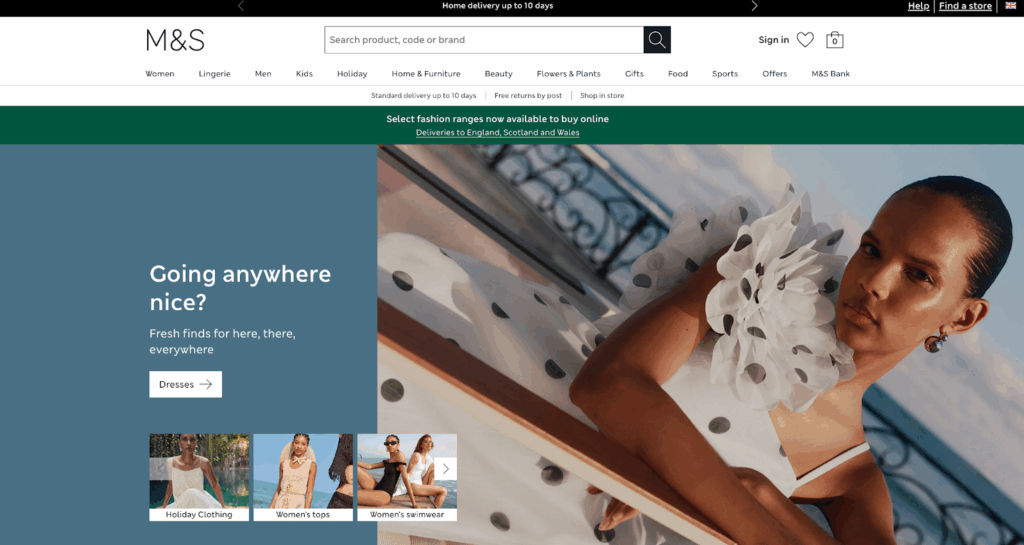
2. Optimize product description with A/B testing and content hierarchy:
The Product Details Pages (PDPs) are arguably the most important pages on your website as they lead directly to a sale. Knowing what information a shopper wants and presenting it in a clear, intuitive manner is the key to its success. Testing different PDP designs with A/B or multivariate testing should form a key part of your Conversion Rate Optimization strategy. Tests may include: adding in social proof, including video, rearranging the hierarchy of different text, improving the readability of the description etc. The example below from argos.com is a strong example of a PDP thanks to:
- A detailed but well-structured product description, broken down into bullet points and directing users to videos on key topics
- A social proof integration in the product gallery
- Clear delivery options
- Alternative payment options with an option to opt into a finance plan
- The option to compare the product to alternatives within the wider product catalogue
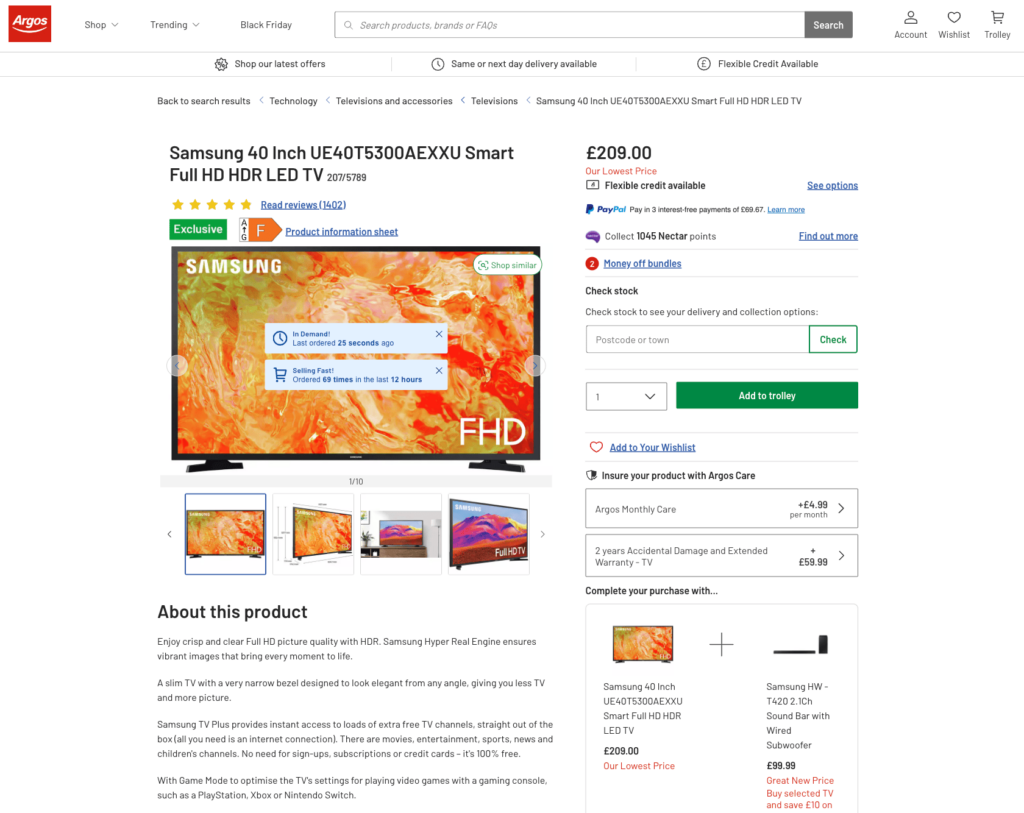
3. Build trust with social Proof Integration:
Weaving in social proof across the buying journey increases shopper trust and is statistically proven to generate consistent and substantial conversion rate uplifts. Social proof can come in many forms including:
1 – Integrated real-time social proof messages on Product Listings Pages, Product Details Pages, at Checkout
2 – Reviews / case studies / comments / testimonials
3 – Influencer / celebrity endorsements
4 – Expert opinion / certification / third party accreditation
5 – Credentials (e.g. 10,000 customers rate Company X outstanding)
This example from Very uses reviews, social proof messages and celebrity endorsement to help build trust with their shoppers.
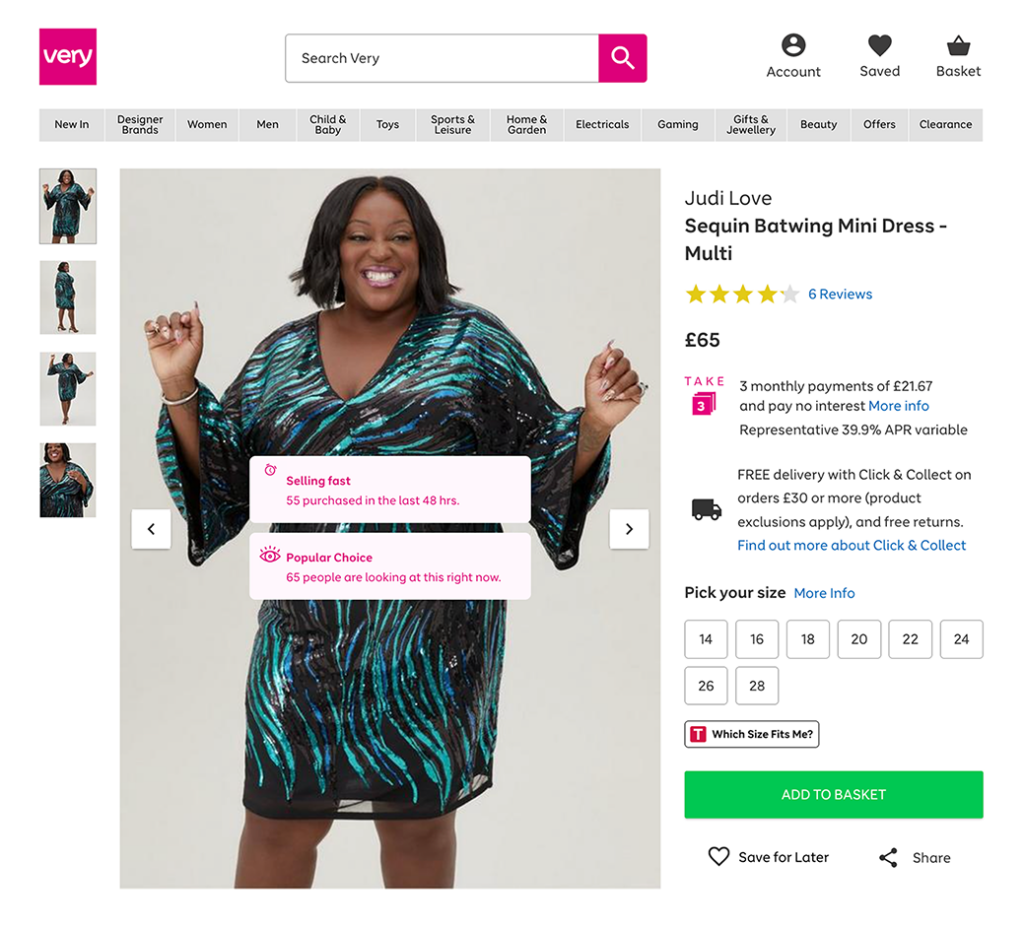
4. Improve User Experience (UX) with simple, intuitive navigation:
Shoppers should be able to quickly and easily identify the section of your site they’re looking for from your navigation. Some key rules of thumb are:
Make labels easy to scan by front-loading the key terms.
For sites with many categories and sub-categories, consider Mega Menus, such as the example below from Crew clothing. These can help shoppers drill down through several layers of the site or skip layers if they need to.
Add visuals to support key themes on the site such as the sale call to action in the example below
Avoid jargon in the link labels. Use terms that are easily identifiable for the shoppers – this will also benefit your SEO efforts
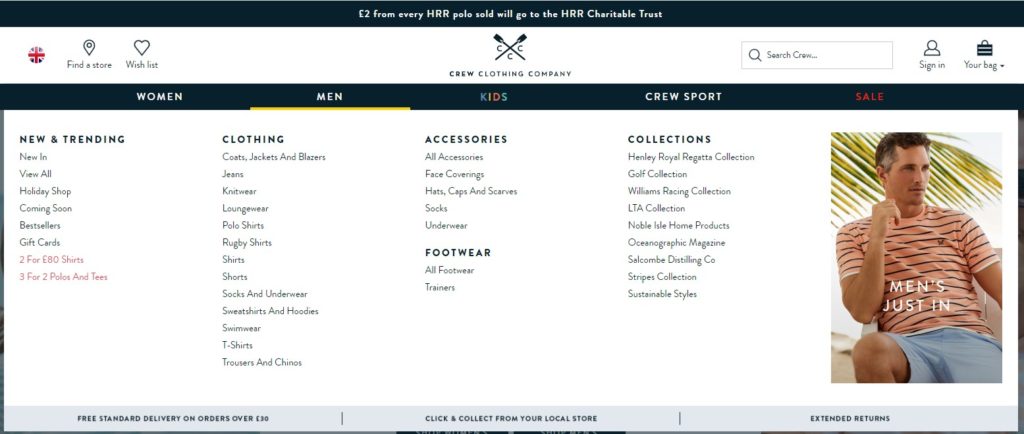
5. Social Commerce:
Promoting and selling products using social commerce is a CRO strategy used by many businesses and has helped create new revenue streams for businesses but for some eCommerce providers, they have also seen higher conversion rates than on their website or app.
The image below is an example of Very‘s Social Commerce strategy – showing one example, in this case, celebrity endorsement.
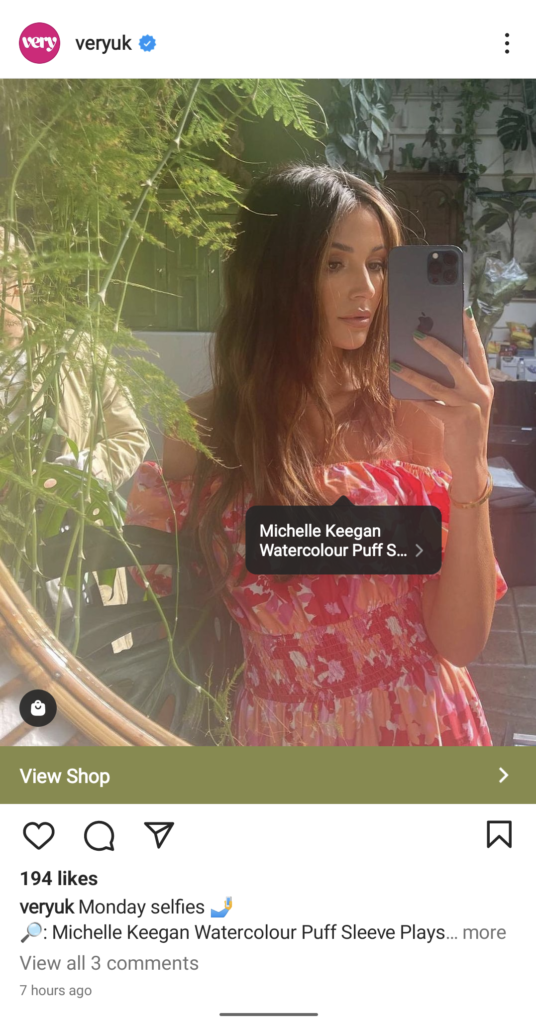
6. Offer targeted discounts:
Offering customers discounts based on their previous browsing behavior can increase the likelihood of converting on your eCommerce site. This can be in the form of overlays on the website or re-engagement emails for shoppers who have abandoned their basket.
Exit overlays can be a very effective method to keep customers on the site and encourage them to purchase. By triggering an exit overlay message to appear as a user is about to leave the site or after they’ve been on the site for a defined period of time, you can provide an offer that encourages them to complete their purchase.
Nobody’s Child take this a step further and encourage it on the Product Details Pages encouraging users to gain a further 25% off by signing up to the newsletter:
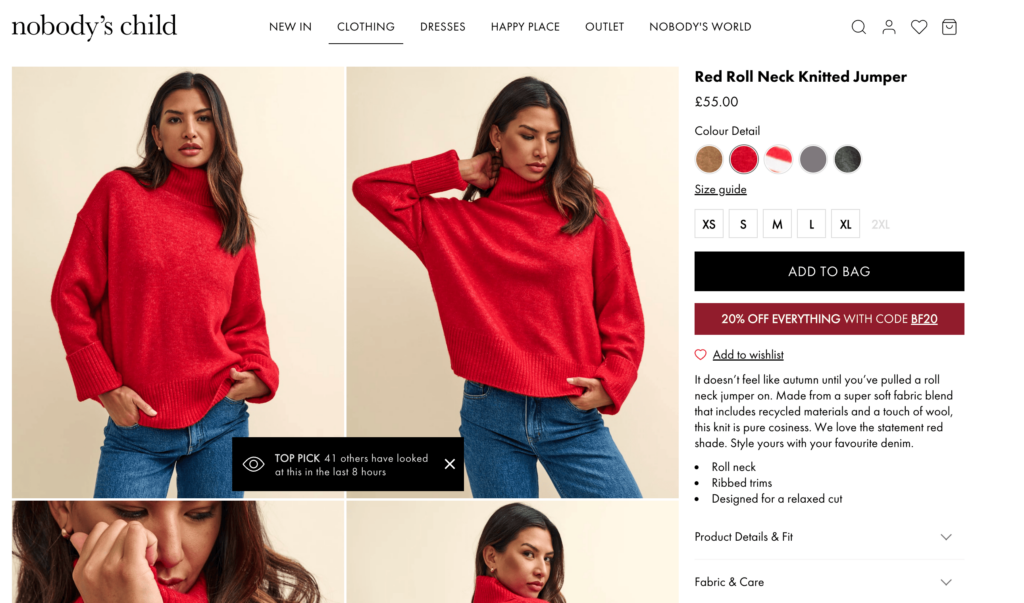
7. Simplify the purchase process with guest checkout:
A common mistake made by eCommerce brands when looking to boost their conversions, is to force users to create an account in order to purchase their items. Not only can this lead to basket abandonment but that shopper may choose never to return. In the example below, you can see the option to continue as a guest.
Offering guest checkout options simplifies the purchasing experience, reducing cart abandonment rates, and directly improving the overall UX on your site.
8. Offer multiple Payment options:
It is crucial for eCommerce brands to understand the audience they’re selling to and what payment options they would expect. For example:
- “Buy now, pay later” options with companies such as Klarna
- Accepting different payment types such as Paypal, Apple Pay in addition to standard credit and debit cards
- Allowing easy coupon or gift card redemption at checkout
This example from Debenhams allows the use of Promo Codes and Pay Later options with 3 interest free payments.
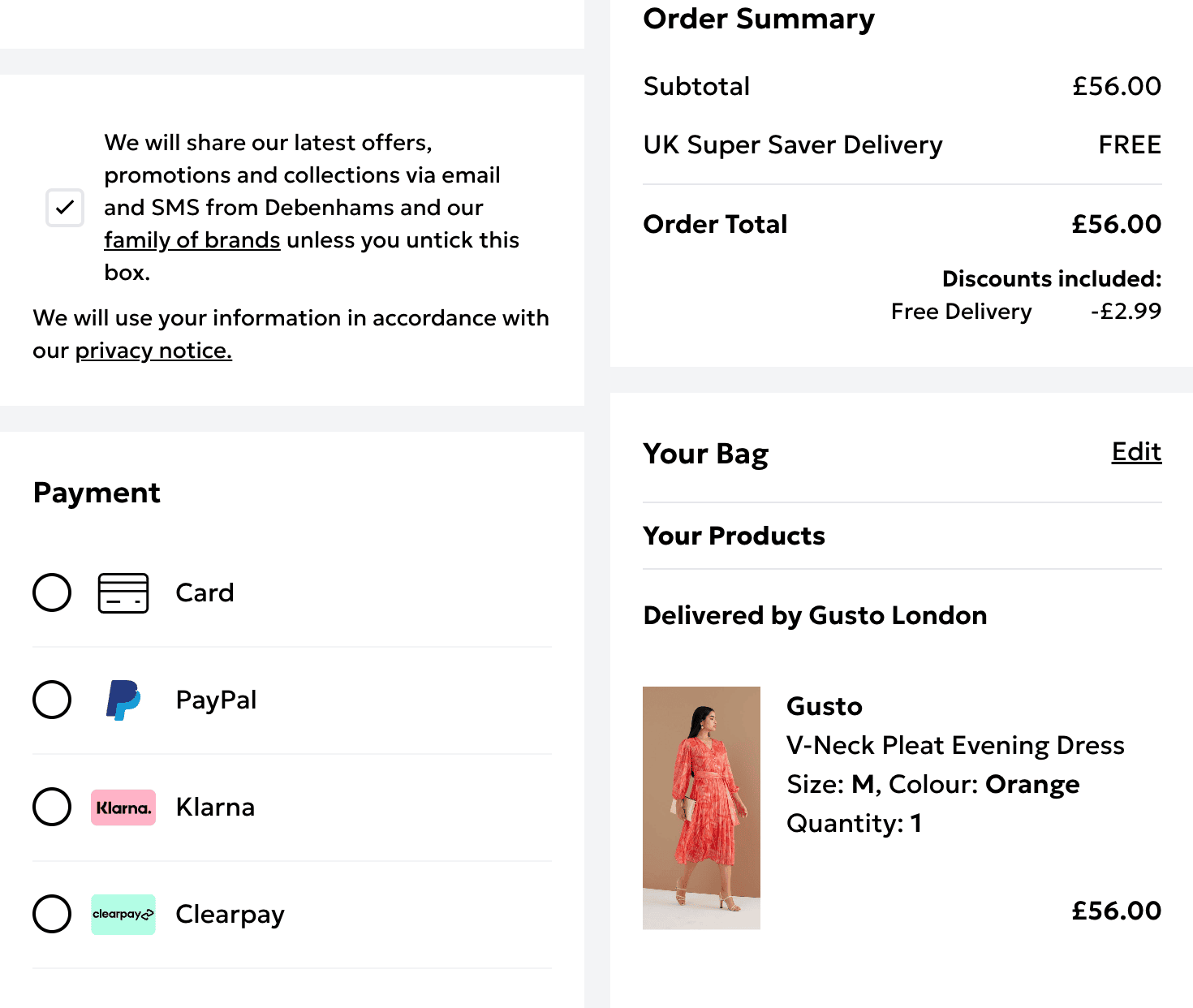
9. Enhance customer experience with multiple delivery options:
Give shoppers the chance to select the best delivery option, or collection point, for them. The example below from ao.com is a great example of not only different delivery options but also details of how the delivery service works so shoppers know what to expect:

10. Strategic re-targeting campaigns:
If a shopper leaves the site without having completed their purchase, you can use both ads and emails to re-engage them depending on how far through the buying journey they are:
- Remarketing Ads: If a user has already left the site, remarketing them using a range of formats such as display ads, social media formats, video etc., can bring them back into the buying journey
- Abandoned Basket Emails: Depending on a Brand’s Privacy Policy and the country(ies) they operate in, if a user has entered their email address during the checkout process before leaving, then there may be an opportunity to send them an abandonment email. This may include an offer and / or related items
11. Form testing to reduce checkout friction:
Using tools such as Visual Website Optimizer you can discover where users drop off in your checkout process. With this data you can redesign your forms and perform A/B tests with the existing and new design to see which performs best.
12. Capture interest with availability notifications:
If a product isn’t currently available but will be restocked, make sure you capture this interest and let shoppers know when the item is back in stock. A simple ‘notify me’ call to action where the ‘buy now’ button would have been is a simple way to capture interest and email shoppers as soon as the item(s) return.
13. Optimize your site speed:
A slow site not only impacts your organic rankings but more importantly, frustrates your shoppers. According to portent.com, a site that loads in 1 second has an eCommerce conversion rate 2.5x higher than a site that loads in 5 seconds. Common factors impacting site speed are:
- Image size: Images should remain under 100KB in size. Consider using plugins such as Imagify or Smush to resize your images
- Limited use of lazy-loading features: Consider lazy-loading images and content that are below the fold
- CSS and JavaScript frequently block the first paint of the page. The key here is to see whether you can delay loading some of the CSS and JavaScript until the first paint of the page is complete
- Third Party Code: Plugins can be great, but they can also slow up the site. If you’re no longer using a certain plugin, remove it from the site. Adding tags to Tag Management solutions can also slow up the site. As with plugins, you want to audit those tags you have in place and see if any can be removed
14. Enhance trust with easy-to-access customer support:
If a shopper was in a physical store, they’d expect to be able to approach a sales assistant and the online experience should be no different. Provide shoppers the option to engage with a virtual assistant or chatbots for out of hours support. This example from Wickes is present across the site, allowing customers to reach out as and when they need.
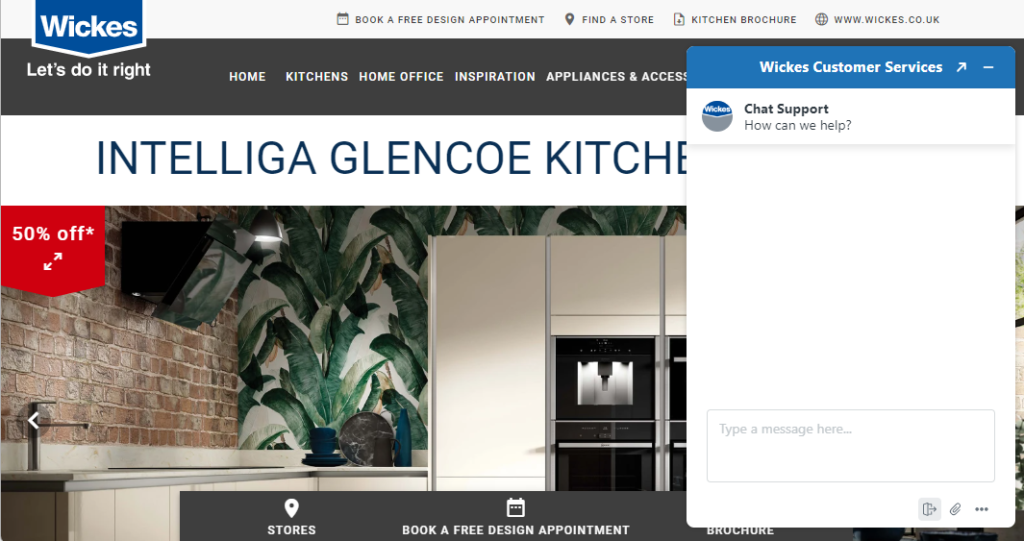
Common Conversion Rate Optimization Mistakes (and How to Avoid Them)
Despite good intentions, ecommerce businesses often make common mistakes that undermine conversion rate optimization efforts:
- Ignoring Mobile Optimization: Many shoppers browse and purchase via mobile devices. Neglecting a responsive design can severely reduce conversions. Always test your mobile experience thoroughly.
- Complex Checkout Processes: Lengthy, complicated checkouts discourage customers. Simplify checkout by offering guest checkout options, streamlined payment methods, and minimal required fields.
- Overlooking Call-to-Action Clarity: Your CTAs must clearly tell users what to expect next. Ensure your CTAs are visible, actionable, and consistent throughout your site.
- Poor-Quality Visuals and Content: Low-quality images or insufficient product information leads to customer hesitation. Always provide high-resolution images, detailed product descriptions, and reviews to build trust and boost conversions.
Avoiding these pitfalls can significantly improve your ecommerce conversion rates and ensure a positive shopping experience for customers.
Top Ecommerce Conversion Rate Optimization Tools
The key to setting out a Conversion Optimization Roadmap is to first understand where users are leaving the site and why.
The below tools are just some of those that can be used to help you gain both quantitative and qualitative insights:
- Microsoft Clarity:
- This is a user behavior analytics tools that helps website owners understand how users are interacting with your website through heatmaps and session replays
- Cost: Free
- Google Analytics
- Google Analytics is a widely used tool that allows brands to measure website traffic, conversions and interactions. This can be used to analyze drop offs in the customer journey and the value of each visit
- Cost: Free
- VWO Form analytics:
- VWO offer a long list of A/B and multivariate testing tools. They also offer Form Analytics so that you can dig further into where shoppers drop off during the checkout process
- Cost: Paid for solution with tiered pricing model
- Social Proof Analytics:
- Taggstar offer a bespoke reporting dashboard that provides real-time reports on the performance of the social proof messages integrated within a brand’s website, app, etc. This provides statistically significant results that quickly identify which messages are actively increasing conversion rates and delivering a higher ROI
Get in touch with us today to find out how we can help you achieve higher ROI.



